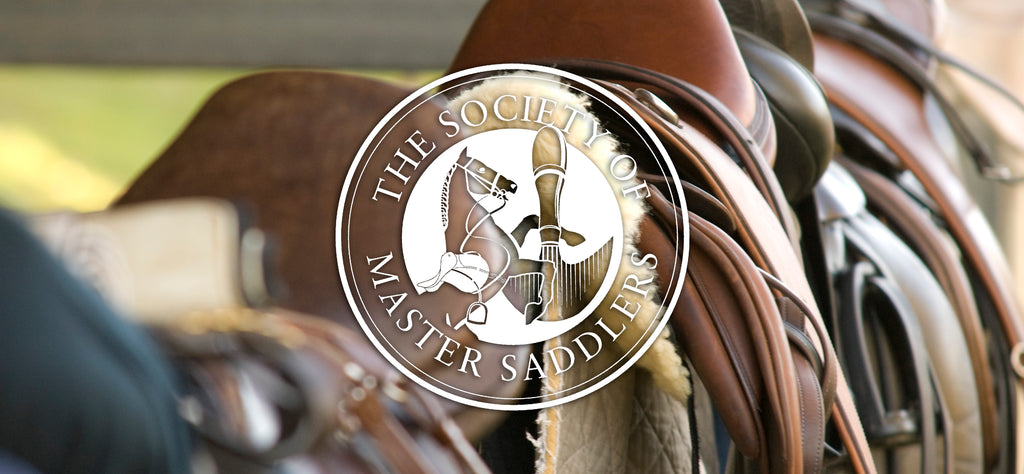About the Society of Master Saddlers

SADDLE FITTING
There are many thousands of words on the internet about saddle fitting, but the Society prides itself on the training and methodology taught to its members. Your guarantee of a satisfactory service is the Society’s much sought after qualification as a Registered Qualified Saddle Fitter.
These pages explain the importance of balance and fit for both you and your horse. A small cost for regular check-ups on your saddle is the route to savings worth hundreds of pounds in corrective treatments if you get it wrong.
Using a Society of Master Saddlers' Registered Qualified Saddle Fitter assures knowledgeable and professional service of the highest standard.
The Society instituted and continues to operate and monitor their professional saddle fitting qualification which is available to UK and international candidates. The qualification has been approved by the City & Guilds London Institute / NPTC, an internationally and UK government recognised awarding body.
Your Society of Master Saddlers' Qualified Saddle Fitter wants to provide a professional service based on knowledge and integrity.
Purchasing a saddle involves considerable expenditure and some important decisions. The saddle fitter is there to provide expertise, advice, help and information.
WHY USE A FITTER
Only a few years ago ‘saddle fitting’ was something in which the vast majority of horse owners displayed little interest. It was only when something went wrong that they called in the services of a saddle fitter – and even then, it could be somewhat reluctantly. By using a Society saddle fitter you are assured of the support of the Society in the unlikely event that you experience any problems with your new saddle.
Things have changed – and for the better. Today the riding public has far greater awareness of the important part the saddle plays in terms of welfare, comfort and success. A well-designed, well-made and well-fitting saddle is an excellent tool. A saddle that is poorly designed - or one that has inherent manufacturing defects - or one that doesn’t fit well is at best a hindrance, at worst, a disaster in the making.


As the most influential professional body in the world connected with saddlery, the Society has put enormous effort into improving saddle fitting standards including instituting what remains the only non-commercially linked saddle fitting qualification in the world. The qualification has been approved by City & Guilds / NPTC, a UK qualification awarding body, and is recognised by equine vets and physiotherapists and other professionals working in the equestrian industry. Before undertaking assessment, candidates for the qualification must have had an absolute minimum of three years’ saddle fitting experience. During the assessment candidates must prove ability to handle horses of different ages and temperaments. They must be able to age horses and describe them in detail, undertake back examinations and locate asymmetric development or sensitive or sore areas. They are required to assess horses walked and run up in hand and identify unlevel steps or lameness. Record keeping, including making wither templates, is also assessed. Above everything, candidates must prove ability to select and fit saddles for horses with widely varying conformation.
In 1999, in conjunction with the British Equestrian Trade Association (BETA), the Society launched a foundation course (now known as the Introductory Course) to promote greater understanding of the basic principles of saddle fitting amongst vets, physiotherapists, BHS Fellows and Instructors and others working within the equestrian industry. More recently application has been extended to those holding the BHS AI and II certificates. Attendance is compulsory for those wishing to progress to the certification course.
In 2000 the Society took a further important step when, with a view to extending expertise in other countries and so improving equine welfare, it launched the Overseas Retailers Qualified Saddle Fitters’ Course. Applicants require recommendation from a UK saddle manufacturing member of the Society. As a result of this enterprise there are now Society qualified saddle fitters as far away as New Zealand and Australia.
The Society has played the major role in educating horse owners and riders about the importance of correctly fitting saddles and is always willing to contribute editorials for any type of equestrian feature and to provide advice in response to readers’ questions. There can be few horse owners who now fail to appreciate that the saddle – and the way it fits – is fundamentally important to the welfare, comfort and success of horse and rider. Likewise, there is now far greater understanding of why - and how - horses ‘change shape’. Thus a saddle that was an acceptable fit when it was purchased may require adjustment – in rare cases, even exchange – at a later date.
Prevention is always better than cure. In a big step forward, more and more horse owners are electing to have the fit of their saddles checked regularly in much the same way as they make regular appointments to have the animal’s teeth checked by an equine dentist.
One underlying factor continues to cause concern. Increased publicity has resulted in others ‘jumping on the bandwagon’ and the ‘second opinion’ is something with which SMS qualified saddle fitters are besieged. Second opinions may emanate from a variety of sources, some more unlikely than others! The recently qualified BHS assistant instructor, the horse owner’s best friend, the vet, the farrier, the physiotherapist... Uncle Tom Cobley and all. Holistic involvement benefits everyone and the vast majority of equestrian professionals and qualified saddle fitters work closely with one another but there is a vast difference between overlap and misappropriation. SMS qualified saddle fitters are professionals who wish to offer the best possible services but this can only be achieved when they are allowed to employ their expertise to the full and without hindrance.
The Society is proud of its reputation for expertise, high standards and integrity.

Leave a comment